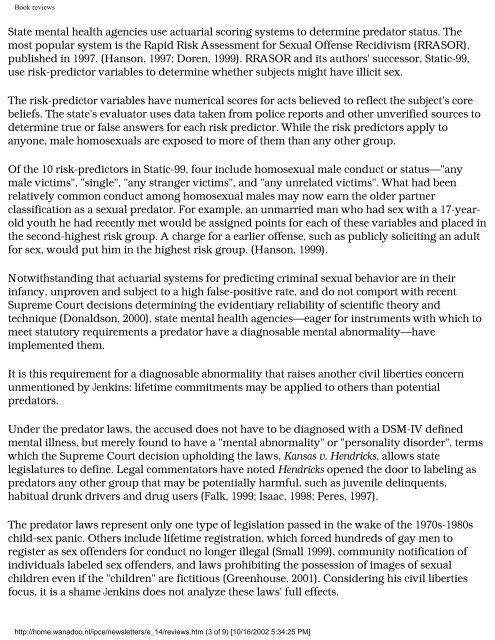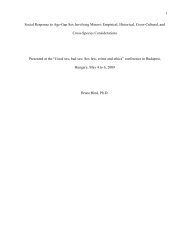PDF file - Ipce
PDF file - Ipce
PDF file - Ipce
You also want an ePaper? Increase the reach of your titles
YUMPU automatically turns print PDFs into web optimized ePapers that Google loves.
Book reviews<br />
State mental health agencies use actuarial scoring systems to determine predator status. The<br />
most popular system is the Rapid Risk Assessment for Sexual Offense Recidivism (RRASOR),<br />
published in 1997. (Hanson, 1997; Doren, 1999). RRASOR and its authors' successor, Static-99,<br />
use risk-predictor variables to determine whether subjects might have illicit sex.<br />
The risk-predictor variables have numerical scores for acts believed to reflect the subject's core<br />
beliefs. The state's evaluator uses data taken from police reports and other unverified sources to<br />
determine true or false answers for each risk predictor. While the risk predictors apply to<br />
anyone, male homosexuals are exposed to more of them than any other group.<br />
Of the 10 risk-predictors in Static-99, four include homosexual male conduct or status—"any<br />
male victims", "single", "any stranger victims", and "any unrelated victims". What had been<br />
relatively common conduct among homosexual males may now earn the older partner<br />
classification as a sexual predator. For example, an unmarried man who had sex with a 17-yearold<br />
youth he had recently met would be assigned points for each of these variables and placed in<br />
the second-highest risk group. A charge for a earlier offense, such as publicly soliciting an adult<br />
for sex, would put him in the highest risk group. (Hanson, 1999).<br />
Notwithstanding that actuarial systems for predicting criminal sexual behavior are in their<br />
infancy, unproven and subject to a high false-positive rate, and do not comport with recent<br />
Supreme Court decisions determining the evidentiary reliability of scientific theory and<br />
technique (Donaldson, 2000), state mental health agencies—eager for instruments with which to<br />
meet statutory requirements a predator have a diagnosable mental abnormality—have<br />
implemented them.<br />
It is this requirement for a diagnosable abnormality that raises another civil liberties concern<br />
unmentioned by Jenkins: lifetime commitments may be applied to others than potential<br />
predators.<br />
Under the predator laws, the accused does not have to be diagnosed with a DSM-IV defined<br />
mental illness, but merely found to have a "mental abnormality" or "personality disorder", terms<br />
which the Supreme Court decision upholding the laws, Kansas v. Hendricks, allows state<br />
legislatures to define. Legal commentators have noted Hendricks opened the door to labeling as<br />
predators any other group that may be potentially harmful, such as juvenile delinquents,<br />
habitual drunk drivers and drug users (Falk, 1999; Isaac, 1998; Peres, 1997).<br />
The predator laws represent only one type of legislation passed in the wake of the 1970s-1980s<br />
child-sex panic. Others include lifetime registration, which forced hundreds of gay men to<br />
register as sex offenders for conduct no longer illegal (Small 1999), community notification of<br />
individuals labeled sex offenders, and laws prohibiting the possession of images of sexual<br />
children even if the "children" are fictitious (Greenhouse, 2001). Considering his civil liberties<br />
focus, it is a shame Jenkins does not analyze these laws' full effects.<br />
http://home.wanadoo.nl/ipce/newsletters/e_14/reviews.htm (3 of 9) [10/16/2002 5:34:25 PM]
















